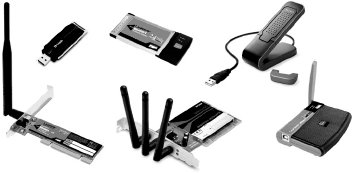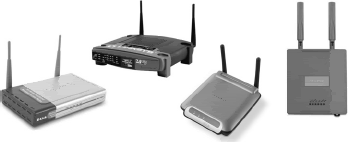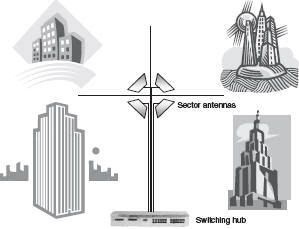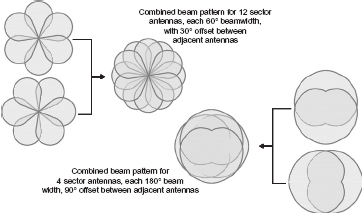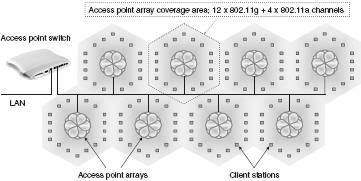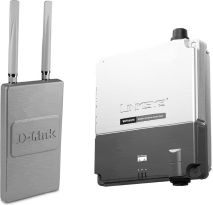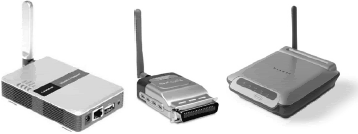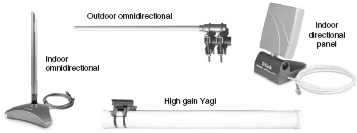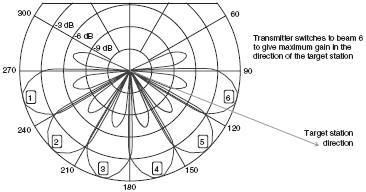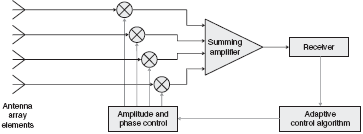Wireless Network Interface Cards
The wireless network interface card (NIC) turns a device such as a PDA, laptop or desktop computer into a wireless station and enables the device to communicate with other stations in a peer-to-peer network or with an access point.
Wireless NICs are available in a variety of form factors (Figure 1), including PC (Type II PCMCIA) and PCI cards, as well as external USB devices and USB dongles, or compact flash for PDAs.
Most wireless NICs have integrated antennas, but a few manufacturers provide NICs with an external antenna connection or detachable integrated antenna which can be useful to attach a high-gain antenna when operating close to the limit of wireless range.
There are few features to distinguish one wireless NIC from another. Maximum transmitter power is limited by local regulatory requirements and, for standards based equipment, certification by the relevant body (such as Wi-Fi certification for 802.11) will ensure interoperability of equipment from different manufacturers.
The exception will be proprietary extensions or equipment released prior to standard ratification, such as “pre-n” hardware announced by some manufacturers in advance of 802.11n ratification. High-end mobile products, particularly laptop computers, are increasingly being shipped with integrated wireless NICs, and with Intel’s Centrino® technology the wireless LAN interface became part of the core chipset family.
Access Points
The access point (AP) is the central device in a wireless local area network (WLAN) that provides the hub for wireless communication with the other stations in the network. The access point is usually connected to a wired network and provides a bridge between wired and wireless devices.
The first generation of access points, now termed “fat” access points, began to appear after the ratification of the IEEE 802.11b standard in 1999, and provided a full range of processing and control functions within each unit, including:
- security features, such as authentication and encryption support
- access control based on lists or filters
- SNMP configuration capabilities
Transmit power level setting, RF channel selection, security encryption and other configurable parameters required user configuration of the access point, typically using a web-based interface. As well as providing this basic functionality, access points designed for home or small office wireless networking typically include a number of additional networking features, as shown in below.
- Internet gateway - Supporting a range of functions such as: routing, Network Address Translation, DHCP server providing dynamic IP addresses to client stations, and Virtual Private Network (VPN) passthrough.
- Switching hub - Several wired Ethernet ports may be included that provide switching hub capabilities for a number of Ethernet devices.
- Wireless bridge or repeater - Access point that can function as a relay station, to extend the operating range of another access point, or as a point-to-point wireless bridge between two networks.
- Network storage server - Internal hard drives or ports to connect external storage, providing centralised file storage and back-up for wireless stations.
Figure 2 illustrates a range of access point types, including weatherproofed equipment for outdoor coverage.
In contrast to the first generation “fat” access point described above, slimmed-down “thin” access points are also available that limit access point capabilities to the essential RF communication functions and rely on the centralisation of control functions in a wireless LAN switch.
Wireless LAN Switches or Controllers
In a large wireless network, typically in a corporate environment with tens and perhaps hundreds of access points, the need to individually configure access points can make WLAN management a complicated task. Wireless LAN switches simplify the deployment and management of large-scale WLANs.
A wireless LAN switch (also known as a wireless LAN controller or access router), is a networking infrastructure device designed to handle a variety of functions on behalf of a number of dependent, or “thin”, access points (Figure 3).
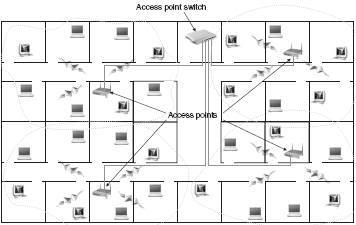
“Thin” Access Point Advantages
- Lower cost - A “thin” access point is optimised to cost effectively implement wireless communication functions only, reducing initial hardware cost as well as future maintenance and upgrade costs.
- Simplified access point management - Access point configuration, including security functions, is centralised in order to simplify the network management task.
- Improved roaming performance - Roaming handoffs are much faster than with conventional access points, which improves the performance of voice services.
- Simplified network upgrades - The centralised command and control capability makes it easier to upgrade the network in response to evolving WLAN standards, since upgrades only have to be applied at the switch level, and not to individual access points.
As shown, this offers several advantages for large-scale WLAN implementations, particularly those supporting voice services. The driver behind the development of the wireless switch is to enable the task of network configuration and management, which becomes increasingly complex and time consuming as wireless networks grow.
A wireless switch provides centralised control of configuration, security, performance monitoring and troubleshooting, which is essential in an enterprise scale wireless LAN.
Taking security as an example, with WEP, WPA, and 802.11i, all potentially in use at the same time in a large WLAN deployment, if security configuration has to be managed for individual access points, the routine management of encryption keys and periodic upgrade of security standards for each installed access point quickly becomes unmanageable.
With a centralised security architecture provided by a wireless switch, these management tasks only need to be completed once. WLAN switches also provide a range of additional features, not found in first generation access points, as described below:
- Layout planning - Automated site survey tools that allow import of building blueprints and construction specifications and determine optimal access point locations.
- RF management - Analysis of management frames received from all access points enables RF signal related problems to be diagnosed and automatically corrected, by adjusting transmit power level or channel setting of one or more access points.
- Automatic configuration - Wireless switches can provide automatic configuration by determining the best RF channel and transmit power settings for individual access points.
- Load balancing - Maximising network capacity by automatic load balancing of users across multiple access points.
- Policy-based access control - Access policies can be based on access point groupings and client lists that specify which access points or groups specific client stations are permitted to connect to.
- Intrusion detection - Rogue access points and unauthorised users or ad hoc networks can be detected and located, either by continuous scanning or by scheduled site surveys.
Lightweight Access Point Protocol
Centralising command and control into a wireless LAN switch device introduces the need for a communication protocol between the switch and its dependent access points, and the need for interoperability requires that this protocol is based on an industry standard.
The Lightweight Access Point Protocol (LWAPP) standardises communications between switches or other hub devices and access points, and was initially developed by the Internet Engineering Task Force (IETF). The IETF specification describes the goals of the LWAPP protocol as follows:
- To reduce the amount of protocol code being executed at the access point so that efficient use can be made of the access point’s computing power, by applying this to wireless communication rather than to bridging, forwarding and other functions.
- To use centralised network computing power to execute the bridging, forwarding, authentication, encryption and policy enforcement functions for a wireless LAN.
- To provide a generic encapsulation and transport mechanism for transporting frames between hub devices and access points, which will enable multi-vendor interoperability and ensure that LWAPP can be applied to other access protocols in the future.
The main communication and control functions that are achieved using LWAPP are summarised below.
- Access point device discovery and information exchange - An access point sends a Discovery Request frame and any receiving access router responds with a Discovery Reply frame. The access point selects a responding access router and associates by exchanging Join Request and Join Reply frames.
- Access point certification, configuration, provisioning and software control - After association, the access router will provision the access point, providing a Service Set Identifier (SSID), security parameters, operating channel and data rates to be advertised.
The access router can also configure MAC operating parameters (e.g. number of transmission attempts for a frame), transmit power, DSSS or OFDM parameters and antenna configuration in the access point. After provisioning and configuration, the access point is enabled for operation.
- Data and management frame encapsulation, fragmentation and formatting - LWAPP encapsulates data and management frames for transport between the access point and access router. Fragmentation of frames and re-assembly of fragment will be handled if the encapsulated data or management frames exceed the Maximum Transmission Unit (MTU) supported between the access point and access router.
- Communication control and management between access points and associated devices - LWAPP enables the access router to request statistical reports from its access points, including data about the communication between the access point and its associated devices (e.g. retry counts, RTS/ACK failure counts).
Although the initial draft specification for LWAPP expired in March 2004, a new IETF working group called Control and Provisioning of Wireless Access Points (CAPWAP) was formed, with most working group members continuing to recommend LWAPP over alternatives such as Secure Light Access Point Protocol (SLAPP), Wireless LAN Control Protocol (WICOP) and CAPWAP Tunnelling Protocol (CTP).
It seems likely that LWAPP will be the basis of an eventual CAPWAP protocol.
Wireless LAN Arrays
The so-called “3rd generation” architecture for WLAN deployment uses a device called an access point array, which is the LAN equivalent of the sectorised WMAN base station illustrated in Figure 4.
A single access point array incorporates a wireless LAN controller together with 4, 8 or 16 access points, which may combine both 802.11a and 802.11b/g radio interfaces.
A typical example uses 4 access points for 802.11a/g coverage, employing 180 sector antennas offset by 90 , and 12 access points for 802.11a covering, with 60 sector antennas offset by 30 , as illustrated in Figure 5.
This type of device, with 16 access points operating 802.11a and g networks at an individual headline data rate of 54 Mbps, offers a total wireless LAN capacity of 864 Mbps. The increased gain of the sector antennas also means that the operating range of an access point array can be double or more the range of a single access point with an omnidirectional antenna.
For high capacity coverage over a larger operating area, multiple access point arrays, controlled by a second tier of WLAN controllers would create a tree topology, as shown in Figure 6, with multi giga-bit total WLAN capacity.
Miscellaneous Wireless LAN Hardware
Wireless Network Bridging
Wireless bridge components that provide point-to-point WLAN or WMAN links are available from a number of manufacturers, packaged in weather proof enclosures for outdoor use (Figure 7).
The D-Link DWL 1800 is one example which bundles a 16 dBi flat panel antenna with a 2.4 GHz radio providing a transmit power of 24 dBm (under FCC) or 14 dBm (under ETSI regulations), to deliver a range of 25 km under FCC or 10 km under ETSI.
Many simple wireless LAN access points also support network bridging, or can be upgraded with a firmware upgrade to provide this capability. Configuring these devices simply involves entering the MAC address of the other endpoint into each station’s access control list, so that each station only decodes packets transmitted by the other endpoint of the bridge.
Wireless Printer Servers
A wireless printer server allows a printer to be flexibly shared among a group of users in the home or office without the need for the printer to be hosted by one computer or to be connected to a wired network.
Typically, as well as wired Ethernet and wireless LAN interfaces, this device may include one or more different types of printer connections, such as USB or parallel printer ports, as well as multiple ports to enable multiple printers to be connected — such as a high-speed black and white laser and a separate colour printer.
A printer server for home or small office wireless networking may also be bundled with a 4-port switch to enable other wired network devices to share the printer and use the wireless station as a bridge to other devices on the wireless network. Figure 8 shows a range of wireless printer servers.
Wireless LAN Antennas
Traditional Fixed Gain Antennas
Antennas for 802.11b and 11g networks, operating in the 2.4 GHz ISM band, are available to achieve a variety of coverage patterns. The key features that dictate the choice of antenna for a particular application are gain, measured in dBi and angular beamwidth, measured in degrees.
The most common WLAN antenna, standard in all NICs and in most access points, is the omnidirectional antenna, which has a gain in the range from 0 to 7 dBi and a beamwidth, perpendicular to the antenna axis, of a full 360 . A range of WLAN antennas is shown in Figure 9.
For sector antennas with a given horizontal beamwidth, the trade-off for higher gain is a narrower vertical beamwidth, which will result in a smaller coverage area at a given distance and will require more precise alignment.
A further important feature of an antenna is its polarisation, which refers to the orientation of the electric field in the electromagnetic wave emitted by the antenna.
Most common antennas, including all those listed in the table above, produce linearly polarised waves, with the electrical field oriented either vertically or horizontally — hence vertical or horizontal polarisation. WLAN antennas that produce circular polarisation are also available (helical antennas) but are less common.
It is important that the polarisations of transmitting and receiving antennas are matched, since a vertical polarised receiving antenna will be unable to receive a signal transmitted by a horizontally polarised transmitting antenna, and vice versa. It is equally important for antennas to be correctly mounted, as rotating an antenna 90 about the direction of propagation will change its polarisation by the same angle (e.g. from horizontal to vertical).
Although WLAN operation in the 5 GHz band has developed more recently than in the 2.4 GHz band, a similar selection of antennas is available for the higher-frequency band. A variety of dual band omnidirectional and patch antennas are also available to operate in both WLAN bands.
Smart Antennas
The data throughput of a wireless network that uses a traditional antenna of the type described above is limited because only one network node at a time can use the medium to transmit a data packet.
Smart antennas aim to overcome this limitation by allowing multiple nodes to transmit simultaneously, significantly increasing network throughput. There are two varieties of smart antenna — switched beam and adaptive array.
A switched beam antenna consists of an array of antenna elements each having a predefined beam pattern with a narrow main lobe and small sidelobes (Figure 10). Switching between beams allows one array element to be selected that provides the best gain in the direction of a target node, or the lowest gain towards an interfering source.
The simplest form of switched beam antenna is the pair of diversity receiver antennas often implemented in wireless LAN access points to reduce multipath effects in indoor environments. The receiver senses which of the two antennas is able to provide the highest signal strength and switches to that antenna.
Adaptive beams or beam-forming antennas consist of two or more antenna elements in an array and a so-called beam-forming algorithm, which assigns a specific gain and phase shift to the signal sent to or received from each antenna element.
The result is an adjustable radiation pattern that can be used to steer the main lobe of the beam in the direction of the desired maximum gain (Figure 11).
As well as focussing its beam pattern towards a particular node, the adaptive beam antenna can also place a “null” or zero gain point in the direction of a source of interference. Because the gain and phase shift applied to individual array elements is under real-time software control (Figure 12), the antenna can dynamically adjust its beam pattern to compensate for multipath and other sources of interference and noise.
Like adaptive beam arrays, Multi-input Multi-output or MIMO radio, described in the Section “MIMO Radio, p. 124”, also uses multiple antennas to increase network capacity.
The key difference between these two techniques is that MIMO radio exploits multi-path propagation between a single transmitter and receiver, while adaptive beam arrays use multiple antennas to focus a single spatial channel. Some other differences are described in Table below.
| Adaptive beam array | MIMO radio | |
| Objective | Focus the propagation pattern along a single desired spatial direction, to allow multiple access, reduce interference or increase range. | Exploit multi-path propagation to increase data capacity by multiplexing data streams over several spatial channels. |
| Antenna configuration | 2 or more antenna elements at Tx and/or Rx. Tx and Rx configurations are independent. | Typically 2 × 2 or 4 × 4 (Tx × Rx). Tx and Rx are linked by the digital signal processing algorithm. |
| Spatial diversity | Single spatial channel focussed between transmitter and receiver. | Multiple spatial channels, exploiting multi-path propagation. |
| Data multiplexing | Single bit stream encoded to all transmit antennas. | Data stream multiplexed over spatial channels. |
| Signal processing | Simple phase and gain modification for each antenna. | Complex processing algorithm to decode signals over multiple spatial channels. |
| Application example | 3rd generation WLAN access points | PHY layer for the 802.11n standard |
Also under development is a new type of switched beam wireless LAN antenna called a plasma antenna, which uses a solid-state plasma (an ionised region in a silicon layer) as a reflector to focus and direct the emitted RF beam.
A plasma antenna will be able to switch a medium gain (10–15 dBi) beam with approximately 10 beamwidth to 1 of 36 directions within a full 360 coverage, with a switching time that is less than the gap between transmitted frames.
